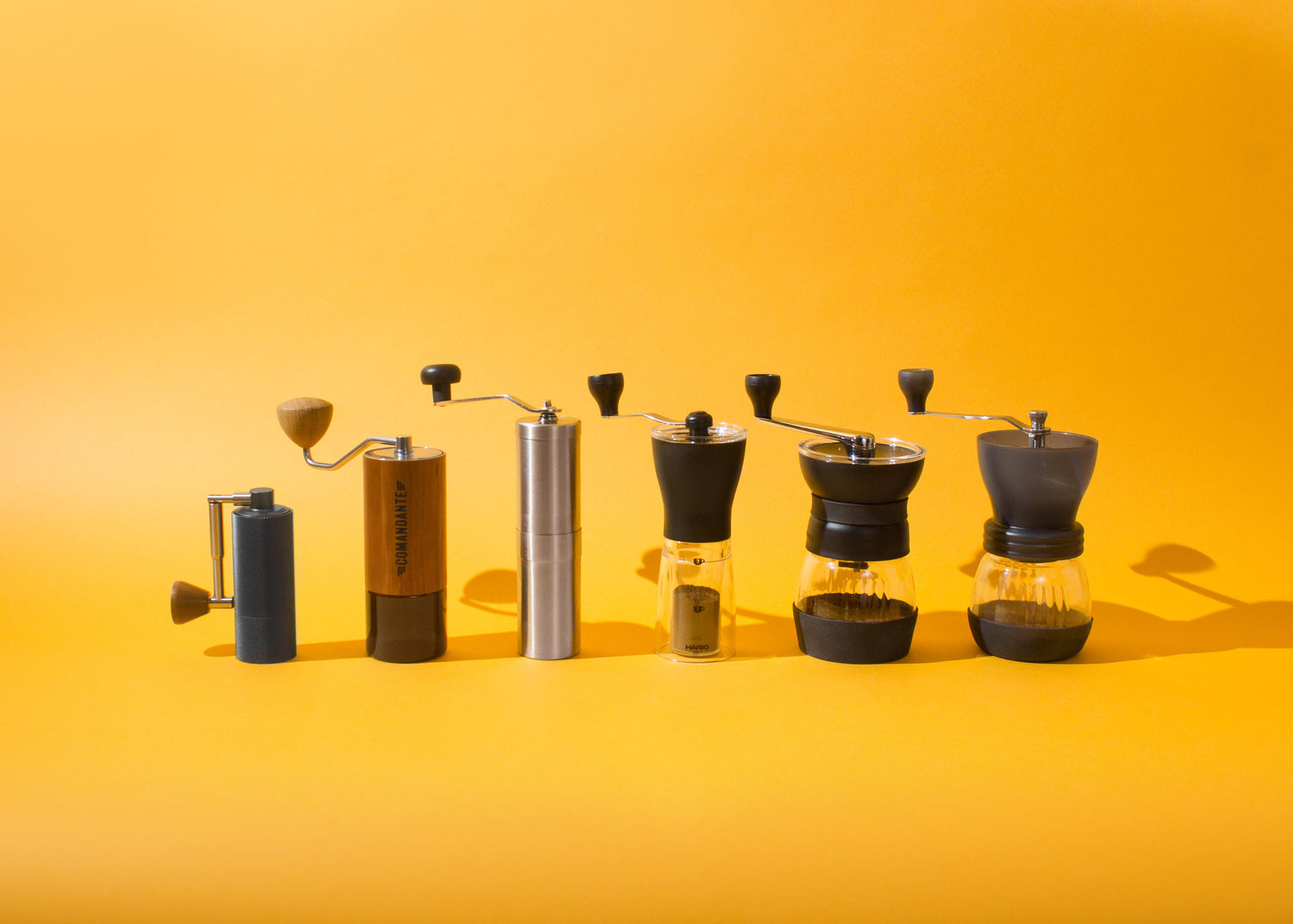A Close-Up Look at Hand Grinders

Making the call when buying a new hand grinder can be a tough decision, and for good reason; getting your hands on a coffee grinder that meets your needs is one of the most significant ways to start making more consistently tasty coffee over time.
Certain grinders are more affordable, some more portable or more durable. Some look better on the counter and some are made with a specific focus on materials. These are all important things to consider when choosing your grinder, because, be honest - how likely are you to use something if you don't actually enjoy it?
There could be many, many articles written about how different hand grinders stack up against these various characteristics (many, many of these articles do already exist), but let's take a deeper dive into one feature that we haven't mentioned yet: grind particle distribution.
Grind particle distribution is a long and somewhat ungainly term, so let's break it down. Most coffee grinders have multiple settings from coarse to fine and many steps between, which is usually achieved by moving an inner, cone-shaped burr and an outer ring-shaped burr either closer together or further apart. The gap between the two burrs is, generally speaking, the resulting size of the coffee particles produced. In a perfect world, every coffee particle would be exactly the same size as this gap, but in reality, the coffee grounds you actually get range from the size of this gap all the way down to a fine powder. When we say "grind particle distribution, we're describing how much of this variation exists within a sample of ground coffee.
The size of a particular coffee particle will affect how quickly the flavours and aromatic compounds inside are released when immersed in hot water - the larger the individual particle, the less surface area is exposed to the water, and the longer it takes to extract flavours from the particle. If you want to read more about solubility vs. surface area in coffee, check out this great article from a previous blog post. If you have a large variety of different coffee particles present in your coffee/water soup, they're all going to be extracting at different rates, causing the cup you get at the end to somehow taste both under- AND over-extracted, a muddy mess. This is why we highly recommend staying away from blade-grinders, which are meant for nuts and spices, and just smash coffee up into every and any size of particle.
With burr grinders, you do get a much narrower window of particle distribution, giving you much more consistent results. That being said, there is a noticeable range even in these types of grinders, with more expensive grinders tending to house higher-precision burrs which eliminate some of this variance (but this isn't a rule, as you'll see in a moment!).
With this in mind, we did some testing of some of our favourite hand grinders here at EIght Ounce Coffee, to see how they compare in terms of grind particle distribution. In this test, we ground 10g of coffee through each grinder and then put the grounds through the Kruve Coffee Sifter, a three-stage sieve that separates ground coffee into coarse particles (called boulders), mid-range usable grinds and fine powder (called fines). For those of you who are interested, I used the 1100μm and 600μm sieve plates in the Kruve. The chart below shows how much coffee ended up in each stage of the sifter after grinding 10g of coffee at approximately the same setting.
| Fines | Mid-range | Boulders | |
| HARIO Slim Mill | 1.5g | 5.1g | 3.5g |
| HARIO Skerton | 0.7g | 5.3g | 4.0g |
| Porlex Tall | 0.9g | 5.5g | 3.3g |
| Comandante | 1.4g | 6.2g | 2.4g |
| HARIO Skerton Pro | 1.1g | 6.3g | 2.7g |
| Timemore Nano | 1.1g | 8.1g | 0.5g |
Now - we know this experiment isn't totally perfect. You'll see that many of these numbers don't add up to exactly 10g, which means that coffee was either lost due to static or that rounding to 0.1 of a gram has caused the numbers to be very slightly off. This was also performed using the display grinders in our showroom, which are all at different levels of use, so it's difficult to tell if this would skew our results. We also only did this experiment once, at one grind setting (medium-fine, or 4 clicks from the finest setting on a Skerton Pro). Some would argue that much of the variance in grind particle distribution is found when grinding very fine, for espresso, or very coarse, for something like french press. Taking all of this into account - this is NOT high-quality scientific data. Even so, we thought this provided quite an interesting insight into what these grinders are capable of under these particular conditions.
The chart moves from lowest consistency at the top (HARIO Slim Mill), to highest consistency at the bottom (Timemore Nano). As the most affordable grinder of the bunch, it's no surprise that the HARIO Slim Mill charted at the bottom, although it's not by a huge margin. What really blew us away were the results of both the Skerton Pro and the Timemore Nano. The Skerton Pro is quite an affordable hand-grinder, at $79, but it has some extra stabilization on the shaft that the inner burr is attached to which really helps to limit some, but not all, of the side to side movement of the burr during grinding, allowing for improved consistency. The Comandante and the Timemore Nano are the only grinders of the bunch that have stainless steel burrs, rather than ceramic, which allows their grind shafts to be fully static, as there is no risk of the burrs shattering if they encounter an under-roasted bean, or a piece of stone or debris that missed the sorting process. The ceramic burrs in hand grinders have to "float" slightly, to be able to take on some shock absorption and not break during use. At $250, the Timemore Nano is not our most expensive hand grinder, but as you can see, it is performing at an incredibly high rate of consistency - I'm think I'm going to be adding one of these to my brewing toolbox soon, that's for sure!
At the end of the day, as mentioned above, there are a lot of other factors that will help you decide what hand grinder makes sense for your lifestyle and brewing needs besides just grind particle distribution. Every grinder on this chart is performing at least reasonably well and will help you make a good cup of coffee, which is why you'll see them on the shelf at Eight Ounce. We hope sharing this experiment will help fuel your brewing curiosity!
- Brett Bonk





